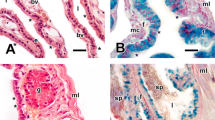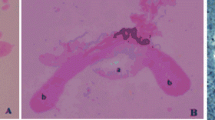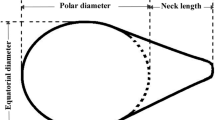Summary
Sperm transfer in the myrmicine antCarebara vidua was studied by making histological sections of newly mated queens. Queens are multiply inseminated, and longitudinal sections through the sperm- filled vagina show that the bundle of sperm from each male is enclosed in a layer of accessory gland secretion terminating in a plug of secretion in the female's vaginal orifice. This spermatophore breaks down soon after mating. The huge quantity of sperm packed into the spermatheca (ca. 16 mm3) suggests that the queen lays a large number of eggs in her lifetime, confirmed by the average of 1672 ovarioles in the two ovaries.
Similar content being viewed by others
References
Ball, D. E. and S. B. Vinson, 1984. Anatomy and histology of the male reproductive system of the fire ant,Solenopsis invicta (Hymenoptera: Formicidae).Int. J. Insect Morphol. & Embryol. 13:283–294.
Cole, B. J., 1983. Multiple mating and the evolution of social behavior in the Hymenoptera.Behav. Ecol. Sociobiol. 12:191–201.
Hermann Jr., H. R. and M. S. Blum, 1965. Morphology and histology of the reproductive system of the imported fire ant queen,Solenopsis saevissima richteri.Ann. ent. Soc. Am. 58:81–89.
Hölldobler, B. and S. Bartz, 1985. Sociobiology of reproduction in ants. In:Experimental Behavioral Ecology (B. Hölldobler and M. Lindauer, Eds.), G. Fischer Verlag, Stuttgart, pp. 237–257.
Hölldobler, B. and E. O. Wilson, 1990.The Ants. Belknap Press of Harvard University Press, Cambridge.
Humason, G., 1972.Animal tissue techniques. 3rd Edition. W. H. Freeman & Co., San Francisco, 641 pp.
Hung, A. C. F. and S. B. Vinson, 1975. Notes on the male reproductive system in ants (Hymenoptera: Formicidae).J. N. Y. ent. Soc. 83:192–197.
Koeniger, G., 1984. Funktionsmorphologische Befunde bei der Kopulation der Honigbiene (Apismellifera L.).Apidologie 15:189–204.
Koeniger, G., 1986. Mating sign and multiple mating in the honeybee.Bee World 67:141–150.
Koeniger, G., N. Koeniger and M. Fabritius, 1979. Some detailed observations of mating in the honeybee.Bee World 60:53–57.
Lepage, M. G. and J. P. E. C. Darlington, 1984. Observations on the antCarebara vidua F. Smith preying on termites in Kenya.J. Nat. Hist. 18:293–302.
Madel, G., D. Muhlen and M. Happe, 1990.Diadegma semiclausum (Hym., Ich.) Begattung, Spermatophorentransfer und Nachkommenschaft.Z. angew. Zool. 77:347–355.
Robertson, H. G. and M. Villet, 1989. Mating behaviour in three species of myrmicine ants (Hymenoptera: Formicidae).J. Nat. Hist. 23:767–773.
Ruttner, F., 1985. Reproductive behavior in honeybees. In:Experimental Behavioral Ecology (B. Hölldobler and M. Lindauer, Eds.), G. Fischer Verlag, Stuttgart, pp. 225–236.
Tschinkel, W. R., 1987a Relationship between ovariole number and spermathecal sperm count in ant queens: a new allometry.Ann. ent. Soc. Am. 80:208–211.
Tschinkel, W. R., 1987b. Fire ant queen longevity and age: estimation by sperm depletion.Ann. ent. Soc. Am. 80:263–266.
Wheeler, D. E. and P. H. Krutzsch, 1992. Internal reproductive system in adult males of the genusCamponotus (Hymenoptera: Formicidae: Formicinae).J. Morph. 211:307–317.
Woyciechowski, M., L. Kabat and E. Król, 1994. The function of the mating sign in honey bees,Apis mellifera L.: new evidence.Anim. Behav. 47:733–735.
Woyke, J., 1979. Effect of the access of worker honeybees to the queen on the results of instrumental insemination.J. apic. Res. 19:136–143.
Author information
Authors and Affiliations
Rights and permissions
About this article
Cite this article
Robertson, H.G. Sperm transfer in the antCarebara vidua F. Smith (Hymenoptera: Formicidae). Ins. Soc 42, 411–418 (1995). https://doi.org/10.1007/BF01242169
Received:
Revised:
Accepted:
Issue Date:
DOI: https://doi.org/10.1007/BF01242169




